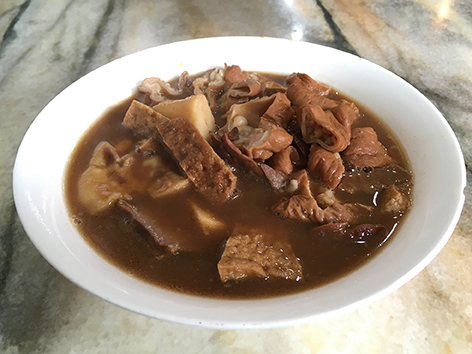Ethiopian Chicken Stew (Doro Wett)
Ethiopia
amantour
guides you to the best local dishes & drinks in
125+ cities. See map now



.jpg) Going somewhere and wish you could take all of a city’s Eat Your World info with you? With EYW’s Kindle and City Guides, you can! Don’t miss out on any local foods or drinks during your next trip.
Going somewhere and wish you could take all of a city’s Eat Your World info with you? With EYW’s Kindle and City Guides, you can! Don’t miss out on any local foods or drinks during your next trip.
EYW wants your food photos!

EYW wants your food stories!
Hey guys I am a traveler who loves to explore different places around the world. I often visit outside of Canada, So whenever I have to travel around the world I always book my flight tickets from the... Read more

What: With a name that literally translates to “stewed bread,” unsuspecting diners may be surprised to find that bread floating in a steaming-hot soup alongside intestines, lungs, and tofu. That may be enough to keep many tourists at a safe distance, but for Beijingers, this traditional local delicacy is beloved as a hearty meal–perfect for those looking for a second wind after a long day at work, or to warm up on a cold winter’s day. A humble meal with lofty aspirations, luzhu huoshao is said to have emerged in the late 1800s, as an imitation of a fabled imperial dish, made with ingredients that commoners could afford. Today, luzhu remains a signature Beijing dish almost impossible to find outside the city. So if you’re on the fence about this one, we say seize the chance to “enjoy” a truly local experience–and impress your Chinese friends in the process.
Good to know: Customers can choose to liven up their luzhu with a range of condiments, usually available at the main counter, where you can spoon in as much as you’d like. Local favorites include garlic and fermented tofu sauce (doufu ru, 豆腐乳, easy to spot with its surprisingly dark pink hue), but we like to keep things simple, with a pinch of hot sauce and cilantro.
Where: Xiaojie Luzhu (小街卤煮) (233 Chaoyangmen Nei Nan Xiaojie, 朝阳门内小街233号, map), a few blocks north of the Beijing Railway Station, is a classic example of a neighborhood luzhu joint. A glass-walled kitchen up front gives diners a clear view of the wide simmering pot where the ingredients are all cooked together, with each neatly arranged in its own corner.
When: Daily, 10am-10pm. This spot is popular with both lunch and dinner crowds, but the place always seems fullest around noon.
Order: A large bowl of luzhu costs just one yuan more than a small bowl (20 RMB), but is almost twice as big–so choose accordingly! For the perfect pairing, pick up a glass bottle of soy milk kept warm in a repurposed rice cooker right next to the cashier. And for those who don’t quite have the guts (pun very much intended) to try luzhu, the restaurant also offers several classic noodle and rice dishes.
Alternatively: Luzhu restaurants are everywhere in the old neighborhoods of Beijing, particularly around Houhai and Dongsi. Further afield, Menkuang Hutong Bainian Luzhu (门框胡同百年卤煮), which boasts a century of luzhu-making experience, has several locations, including in Xinjiekou 新街口(Zhao Dengyu Lu 2 赵登禹路2号, map) and Guomao 国贸(Guanghua Lu 7 光华路7号, map).
©2025 Eat Your World, LLC - All Rights Reserved